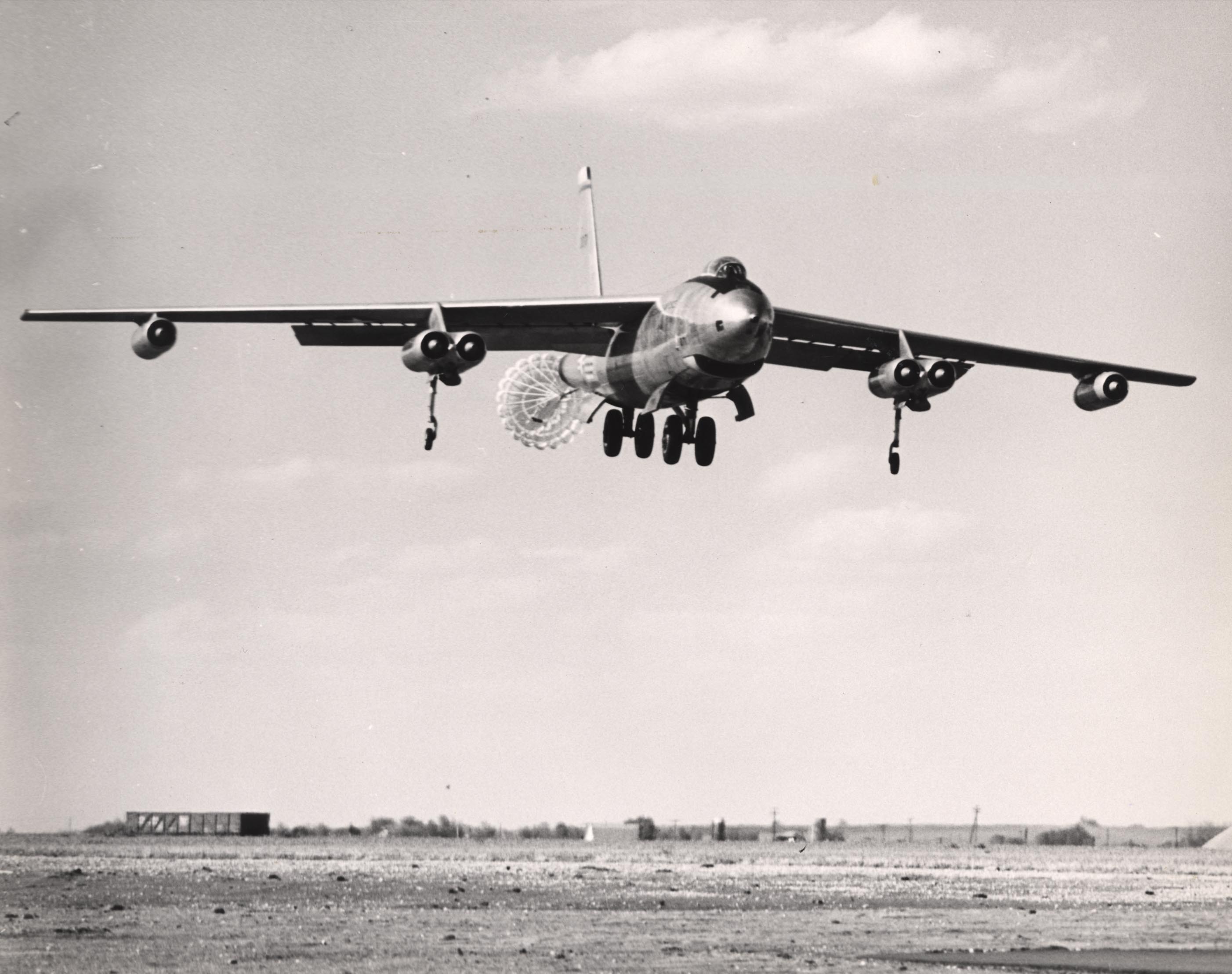The B-47 Stratojet - Lincoln's Cold Warriors

An early B-47E on approach at Lincoln Photo: Jim Dunlap
William Haydon Collection (Early model B-47Es at Lincoln circa 1955) - Special Thanks to Scott Haydon
Duane Koss Collection - Last 98th BW B-47s Nov/Dec 1965
Terry Worley Collection - B-47s on Lincoln ramp
Various B-47s on Lincoln Ramp (USAF Photos)
Boeing B-47E Stratojet
Class: Medium Bomber
Crew: 3 (Pilot, Co-Pilot, Navigator/Bombardier)
Maximum Speed: 606 mph
Combat Radius: 2,013 miles
Service Ceiling: 33,100 ft
Armament: 2 20mm Cannon in tail
25,000 lb bomb load including 2 nuclear free-fall bombs or 13 500 lb conventional bombs (in short bay configuration)
Length: 107 ft
Wingspan: 116 ft
Height: 28 ft
Produced at three assembly plants, Boeing - Wichita, Douglas - Tulsa, Lockeed - Marietta
Service at Lincoln AFB December 7, 1954 - December 7, 1965
Class: Medium Bomber
Crew: 3 (Pilot, Co-Pilot, Navigator/Bombardier)
Maximum Speed: 606 mph
Combat Radius: 2,013 miles
Service Ceiling: 33,100 ft
Armament: 2 20mm Cannon in tail
25,000 lb bomb load including 2 nuclear free-fall bombs or 13 500 lb conventional bombs (in short bay configuration)
Length: 107 ft
Wingspan: 116 ft
Height: 28 ft
Produced at three assembly plants, Boeing - Wichita, Douglas - Tulsa, Lockeed - Marietta
Service at Lincoln AFB December 7, 1954 - December 7, 1965

B-47E on take-off with water-alcohol injection at Lincoln
(LAFB Base Guide 1962)
Brief History:
In 1944, US Army Air Forces issued a requirement for a new jet bomber. A number of contractors stood forward for the task offering the B-45 (North American), the B-46 (Consolidated-Vultee), the B-48 (Martin) and the B-49 (Northrup). Boeing based its design around obtained aerodynamic studies performed by Germany in World War II - offering an advanced, swept wing design. This became the B-47
First flying in 1947, the B-47 would not enter service with the Strategic Air Command until 1951. A great deal of engineering work was required to provide a workable, combat-ready aircraft. In 1954, it had officially replaced the wartime B-29 type with the last bomber variant leaving SAC service in November (a part of the 307th Bomb Wing at Kadena Air Base, Okinawa)
Lincoln Service
The first B-47 arrived at Lincoln on December 7, 1954 with a number soon entering trial service with the 98th Bomb Wing. The 307th Bomb Wing would be equipping a short time later in March 1955. An immediate need was to certify combat crews and get wings into "combat-ready status" as soon as possible. Simulators were installed to provide ground-based training in addition to classroom work. By early 1956, a combat-ready 98th Bomb Wing departed for a temporary deployment to England. The 307th replaced them that summer.
The Stratojet
Jet-powered, swept winged and only crewed by three persons, the B-47 was a very challenging aircraft to fly. Unfortunately it would be cursed with a high-accident rate throughout its life. It's very revolutionary nature at a time with primitive early jet engines (the J-47 was slow to respond to throttle commands) and it's high landing speed provided a steep learning curve for crews. On the other hand, it was fast and relatively agile. A forerunner to much of today's airliner fleets.
As a bomber
Initially tasked as a high-altitude bomber, the increasing risks of Soviet air defenses mandated that the B-47 fly lower to avoid them. It was expected that 3-ship cells would penetrate Soviet airspace flying low after the 1959 period, popping up to deliver deadly megaton-range nuclear cargoes. Training at low level also meant increased stress on the aircraft, and after a series of deadly accidents nationwide involving wing structure, a modification program was implemented to strengthen the wings on the bombers.
Into the 60s
Going into 1959, the B-47 was the clear backbone of the Strategic Air Command with over 1,200 bombers in its inventory. However numbers would begin to recede thereafter. While the B-58 was considered the B-47s successor, the cost of that aircraft was high. B-52s would come to represent SAC in the coming years instead.
A last hurrah
The Kennedy Administration in early 1961 decided it was time to phase out the B-47 in favor of ballistic missiles, yet due to rising tensions over Berlin that year it was decided to retain a good portion of the B-47 fleet at least until 1966. At Lincoln, both the 98th and 307th Bomb Wings remained at full strength. In 1958 it was decided to forward position a handful of B-47s on three week tours overseas instead of the entire wing and "Reflex Action" was a code word that was quickly known at Lincoln. B-47s forward deployed to bases in England and Spain until 1965.
"Clutch Pedal" was complimented in 1960, dispersing B-47s to civilian airports in case of crisis. This was performed only once, during the Cuban Missile Crisis, when Lincoln's B-47s stood high nuclear alert. Many aircraft were configured to become airborne within 15 minutes warning to respond to nuclear attack.
Phase-Out
After the Cuban Missile Crisis, the B-47 quickly left SAC service. Lincoln units were fully equipped going into 1965, some of the last B-47 units nationwide. The 307th Bomb Wing would release its last B-47 in March 1965 with the 98th Bomb Wing (now Strategic Aerospace Wing) flying theirs into retirement on December 7, 1965 - exactly 11 years after the first landed at Lincoln. By Februrary 1966, the B-47 bomber was out of American service. While a challenging and even deadly aircraft to fly, the Stratojet provided the United States with a credible nuclear deterrent during the high Cold War years. Today, a handful are found in museums with only one Lincoln B-47 remaining on a pedestal at McConnell Air Force Base in Kansas.
Suggested Reading:
Hill, Michael: "Cold War Cornhuskers" Schiffer books
Hopkins, Robert S. and Habermehl, C Mike "Boeing B-47 Stratojet: Strategic Air Command's Transitional Bomber" Crecy Publishing
Lloyd, Alwyn T. "Boeing's B-47 Stratojet" Specialty Press